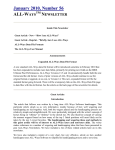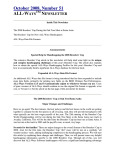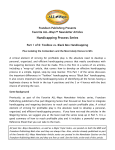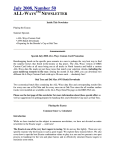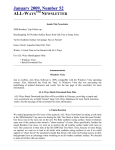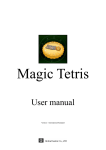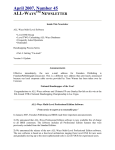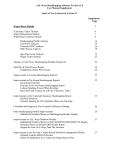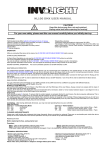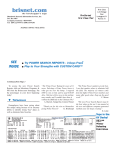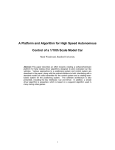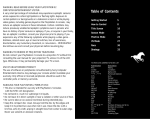Download Handicapping the Full Race Cards on Triple Crown
Transcript
Frandsen Publishing Presents Favorite ALL-WaysTM Newsletter Articles Handicapping the Full Race Cards On Triple Crown Saturdays “Accentuate the Positive and Eliminate the Negative” This article presents some ideas for handicapping the three individual Triple Crown races, specifically the Kentucky Derby, the Preakness and the Belmont Stakes. Then we turn our attention to the main subject of the article which is handicapping the full race cards on the three Triple Crown Saturdays. After all, this is where we focus most of our attention and handicapping efforts on these three big days of racing each year. More specifically, the article explains techniques to narrow down the full fields of horses on Triple Crown Saturdays by approximately 40% so we can focus on the horses we should consider in our wagers (“Accentuate the Positive”) and avoid the horses we should not consider (“Eliminate the Negative”). For non ALL-Ways Users Even if you are not an ALL-Ways user, you will gain valuable insights from this article for handicapping the full race cards on Triple Crown Saturdays. Many of the concepts “travel well” and can be used effectively with information from other sources such as the BRIS Ultimate Past Performances. Plus, each year, Frandsen Publishing provides very simple instructions on their Web site for using ALL-Ways Software like a "Tip Sheet" for Triple Crown Saturdays. This makes it possible to use the concepts presented in this article without having to learn all the details about the software. See the end of this article for more information. “Heads Up” Be sure to pay close attention to the discussion later in this article about the Best Late/Best Early Group. It may well be the single most valuable piece of handicapping information you will use for handicapping the full race cards on Triple Crown Saturdays! All past ALL-Ways Newsletters, as well as a Major Topic Index, are posted on both the BRIS and Frandsen Publishing Web sites and they are always free. Also, articles already published as part of the Favorite ALL-Ways Newsletter Article series are posted in the Newsletter Section on the Frandsen Publishing Web site and they are free as well. See the links at the end of this article. The Three Triple Crown Races Three different horses won the three Triple Crown races in 2010. At the time this article was written, we had gone 32 years without a Triple Crown winner since the feat was last accomplished by Affirmed in 1978. So, why has it been so difficult for horses to win the Triple Crown? We believe the answer is because of the absolute grueling schedule and tough race distances these three year old horses experience during the five week period the three races are run. Consider this: These horses are generally accustomed to several weeks off between races until they hit the Kentucky Derby. Then, in the Derby, they face very tough competition at the same time they must run a 1 1/4 mile race for the very first time. Then they get only two weeks off until they must run the 1 3/16 mile Preakness. Then, they get only three weeks off until they must run the 1 1/2 mile Belmont Stakes. Like we said, this is a grueling endeavor. Obviously, not many horses can handle it. The Kentucky Derby “The Run for the Roses” The Kentucky Derby is run every year at Churchill Downs in Louisville Kentucky on the first Saturday in May. The Kentucky Derby is one of the most difficult races to handicap, virtually every year. The race has 3-year old horses that are still maturing, racing against the toughest competition they have ever faced, running in a generally fast paced race, trying to run the longest distance thus far in their young careers (1 1/4 mile) and doing all of this facing the largest field of horses they will ever face in their entire careers. Favorites simply do not win the Derby very often. The statistics below focus on the Derby winners from 2000 through 2010, but exclude the 2005 and 2009 races that were won by 50-1 “Giacomo” and 51-1 “Mine That Bird” respectively. (Continued) Races Won by a Horse Ranked in the Top 3 for the Factor (Kentucky Derby) Factor Races Won BRIS Speed 2/3 8 of 9 BRIS Combined 2/3 8 of 9 BRIS Late 2/3 7 of 9 7 of 9 BRIS Prime Power BRIS Combined = BRIS Early Pace + BRIS Final Fraction Pace BRIS Late = BRIS Final Fraction Pace + BRIS Speed BRIS Prime Power = An overall comprehensive rating 2/3 = Average for the horse’s best 2 out of its last 3 races This shows that 8 of the 9 Kentucky Derby winners ranked in the top three of the BRIS Speed 2/3 and the BRIS Combined 2/3 factors. BRIS figures are standard in ALL-Ways Software. ALL-Ways Software also includes the unique Hall pace and speed figures that use the concept of “conservation of energy” to normalize the pace and speed figures to the exact distance of today’s race. ALL-Ways Software also includes a Comprehensive Rating similar to the BRIS Prime Power Rating. The chart below shows the results of using both sets of factors. Races Won by a Horse Ranked in the Top 3 for the Factor (Kentucky Derby) Factor Races Won BRIS or Hall Speed 2/3 9 of 9 BRIS or Hall Combined 2/3 9 of 9 BRIS Power or ALL-Ways Comp. 9 of 9 BRIS or Hall Late 2/3 7 of 9 This shows us that every winning horse in these 9 Kentucky Derby races was ranked in the top 3 for BRIS and/or Hall Speed 2/3 AND for BRIS and/or the Hall Combined 2/3 AND for BRIS Prime Power and/or ALL-Ways Comprehensive. statement is the word “AND”. The power of this Handicapping the Kentucky Derby The Kentucky Derby always has large fields. Both the 2009 and 2010 Kentucky Derby races had 20 horse fields. One good way to approach the Kentucky Derby is to start by trying to reduce the number of horses in this large field that you will give serious consideration to for your wagers. Some horses will, of course, just jump out at you as not having a chance to finish in-the-money. Here are some helpful handicapping considerations for narrowing down the large Kentucky Derby field of horses. Post Position: Not a single winning horse came out of the first three post positions during any of the eleven Kentucky Derby races run since 2000. This may well be because inside posts tend to be a problem for horses getting trapped behind a "wall of horses" going into the stretch run in the large Derby fields. BRIS Combined 2/3: Another good eliminator is to downgrade horses that are not ranked in the top 10 of key handicapping factors. For example, looking at all eleven Kentucky Derby races run since 2000, 28 of the 33 in-the-money finishers were ranked in the top 10 for the BRIS Combined 2/3 factor. Pace Considerations: Most Kentucky Derby races are run at a fast early pace. The 2010 Kentucky Derby had a very fast ALL-Ways Race Pace Shape of “EEE” meaning there were three or more Early (“E”) horses. There are two particularly strong ways to help assess if a horse can handle the pace. One is to look at how the horse ran in its past performance race(s) where the early pace pressure was strong. Using the ALL-Ways Past Performance Handicapping Report, look for races that had a Quirin Race Shape of “FF” or “FP”. These mean the past performance race had a “Fast” early pace and a fast final time (“FF”) or the race had a fast early pace and a Par final time (“FP”). If the horse did well, it's a player today. If it did poorly, it will likely have trouble today. If the Kentucky Derby race has a fast early pace, you will want to give extra credit to the best late running horses with running styles of Presser (“P”) or Sustainer (“S”). Pay particularly attention to the horses that rank high in the ALL-Ways Best Late List. Distance Considerations: None of the horses will have run the 1 1/4 mile distance before. However, many of the horses will have run in a 1 1/8 mile race. Look at these past performance races to see if the horse did well, did just OK or did poorly. We particularly look for horses that were gaining ground or extending their lead down the stretch. Again, the long distance of the Derby favors closers. Later in this article, we present some other effective methods to substantially reduce the number of horses you consider for all Triple Crown Saturday races. The Preakness "The Run for the Black-Eyed Susans" The Preakness is always run exactly two weeks after the Kentucky Derby, more specifically on the third Saturday in May. It is run at the Pimlico race track in Baltimore, Maryland. The Preakness is a 1 3/16 mile dirt race. The Pimlico track has somewhat longer straightaways and sharper turns than Churchill Downs. The field sizes since 2000 have averaged around 11 horses. The Preakness is not as difficult to handicap as the Kentucky Derby. With that said, the Preakness is still a very competitive and high class race. It is still a race for rapidly maturing 3-year olds. One important added handicapping complexity is that the Kentucky Derby horses running in the Preakness are coming back in only two weeks after competing in one of the toughest races they will ever encounter. The statistics below focus on all eleven Preakness winners from 2000 through 2010. Races Won by a Horse Ranked in the Top 3 for the Factor (Preakness) Factor Races Won True Dirt Speed 10 of 11 BRIS Speed 2/3 10 of 11 Hall Speed 2/3 10 of 11 BRIS Prime Power ALL-Ways Comprehensive BRIS Power or ALL-Ways Comp 10 of 11 9 of 11 11 of 11 True Dirt Speed = Average BRIS Speed on a dry dirt track at the same distance category of today’s race (sprint or route) Something not shown above, but that is very important, are what we call "eliminators". There were absolutely no wins by horses not ranked in the top half of the field for either the BRIS Late 2/3 factor (BRIS Early Pace + BRIS Speed) or the ALL-Ways Comprehensive factor or the BRIS Prime Power factor. In other words, if a horse was not ranked in the top half of all three of these factors, it did not win. This will quickly reduce the horses you consider for the win position. Handicapping the Preakness Normal handicapping approaches work well for the Preakness. One thing to note is that 23 of the 33 in-the-money finishers since 2000 were either Presser “P” horses or Sustainer “S” horses. The remaining 10 horses were either Early “E” horses or Early Pressers “EP”. This indicates the Best Early/Best Late strategy should work well for Exacta and Trifecta wagers. The Preakness is notorious for low win payoffs, but the Exacta and Trifecta frequently pay well. Once again, look at the ALL-Ways Best Late List for the higher odds top 4 finishers. Belmont Stakes “The Run for the Carnations” The Belmont Stakes, the third and final leg of the Triple Crown, is always run exactly three weeks after the Preakness. Handicapping the Belmont Stakes An interesting fact: As of the date this article was written, in the years since we last had a Triple Crown winner (Affirmed in 1978) there have been eleven horses that won both the Kentucky Derby and the Preakness, but then failed in the Belmont Stakes. The two big handicapping challenges are the length of the race (1 1/2 miles) and, in the case of horses who competed in the Kentucky Derby and/or the Preakness, the ability of the horses to handle such a demanding race after such a short layoff between races. From a distance standpoint, we obviously need to find horses that did well in their prior long races in terms of gaining ground down the stretch. Horses that were "backing up" at the end of the Kentucky Derby or the Preakness are probably not good candidates to win the Belmont Stakes. From a stamina standpoint, we want to find horses that have come back to do well after a short layoff. Here are some statistics for the in-the-money finishers in the Belmont Stakes since 2000 excluding the 2002 race which was won by Sarava at 70 to 1 odds. (As an aside, the Hall pace and speed figures in ALL-Ways Software did find Sarava.) (Continued) In-the-Money Performance of Top Ranked Horses for the Factor (Belmont Stakes) Factor Win Place Show Top 3 Top 4 Top 4 BRIS Speed 2/3 6 of 10 7 of 10 9 of 10 6 of 10 True Dirt FF 7 of 10 9 of 10 6 of 10 BRIS CMB 2/3 BRIS Late 2/3 6 of 10 7 of 10 7 of 10 7 of 10 Comprehensive 6 of 10 8 of 10 7 of 10 BRIS Class BRIS Power 5 of 10 8 of 10 8 of 10 9 of 10 7 of 10 8 of 10 4 of 10 True Dirt FF = Average BRIS Final Fraction Pace on a dry dirt track at the same distance category of today’s race (sprint or route) BRIS Combined = BRIS Early Pace + BRIS Final Fraction Pace BRIS Late = BRIS Final Fraction Pace + BRIS Speed BRIS Prime Power = An overall comprehensive rating Comprehensive = an ALL-Ways overall comprehensive rating 2/3 = Average for the horse’s best 2 out of its last 3 races Using BRIS Speed 2/3 as an example: 7 of the 10 winning horses were ranked in the top 3 of BRIS Speed 2/3. 8 of the 10 place horses ranked in the top 4 of BRIS Speed 2/3. 7 of the 10 show horses were ranked in the top 4 of BRIS Speed 2/3. (Next: Handicapping the Full Race Cards on Triple Crown Saturdays) Handicapping the Full Race Cards on Triple Crown Saturday Now, we turn our attention to handicapping all the races on the three Triple Crown Saturday race cards. We discuss ways to dramatically narrow down the field of horses you consider for your wagers, on average by about 40%. After applying these methods, here is how the remaining horses did on 2009 and 2010 Triple Crown Saturdays. Top 4 Finishers After Eliminating Approximately 40% of the Fields 2009 Triple Crown Saturdays CDX PIM BEL TOTAL RACES 13 13 13 39 WIN 12 12 13 37 of 39 PLACE 12 12 13 37 of 39 SHOW 13 12 10 35 of 39 4TH Totals 12 49 of 52 12 11 48 of 52 47 of 52 35 of 39 144 of 156 2010 Triple Crown Saturdays CDX PIM BEL TOTAL RACES 13 13 13 39 WIN 13 12 13 38 of 39 PLACE 12 12 11 35 of 39 4TH 11 12 SHOW Totals 13 49 of 52 11 12 12 47 of 52 48 of 52 36 of 39 35 of 39 144 of 156 Using the 2010 figures, here is how to read this chart. On the Churchill Downs full race card, all 13 winners and all 13 show horses were included. Only one place horse and two fourth place horses were missing. Also, 38 of the 39 winners in these 39 races run at all three tracks were accounted for, with only one horse missing. In both years, after applying the elimination concepts, the remaining horses accounted for a whopping 144 of the 156 win, place, show and 4th place finishers. Only 12 of the 156 top four finishers were missing in all 39 races! Later in this article, we will provide some ideas for identifying some of these 12 missing horses as well. Reminder for Non ALL-Ways Users Frandsen Publishing provides simple instructions on the Frandsen Web site for using ALL-Ways Software like a "Tip Sheet" for handicapping the full race cards on Triple Crown Saturdays. This makes it possible to use the concepts presented in this article without having to learn all about the software. See the last page of this article for more information. Now, let's look at how this handicapping concept works. You will notice two things: First, you will notice that it strongly points to the most likely top four finishers so your wagers are focused on the right horses (Accentuate the Positive). Second, you will see that it is a very good way to eliminate non contender horses so you reduce your bets on the wrong horses (Eliminate the Negative). The Four Groups Four features in ALL-Ways can be viewed as being “groups” of horses that are qualified to be in the particular “group”. We are going to cover each group individually and show how well they did for the full race cards on Triple Crown Saturdays. Each group is impressive by itself, but don't get “hung up” on a single group. Towards the end of this article we will summarizes how these groups all worked together. The four groups are: 1) “Contenders” 2) “Key Horse Candidates” 3) “Best Late/Best Early Horses” 4) “Top 10 Speed Performances” ALL-Ways Software automatically does a tremendous amount of analysis “behind the scenes” to determine the horses that are qualified for each of the four groups and it would be foolish to not take advantage of all this work automatically being done for you. So, we do suggest starting your handicapping with these four groups, but then add some of your own handicapping and wagering skills to the effort. After we review each of the four groups, we will present handicapping process suggestions for you to use to effectively accomplish this. Percentage of the Full Fields in Each Special Group on Triple Crown Saturdays 2009 Triple Crown Saturdays CDX PIM BEL Full Fields 124 112 122 Contender 50% 55% 48% Key Horse 42% 46% 43% Best Late/Early 49% 54% 49% Top 10 Speed 56% 59% 57% 2010 Triple Crown Saturdays CDX PIM BEL Full Fields 123 116 120 Contender 52% 55% 54% Key Horse 42% 45% 53% 43% 53% Top 10 Speed 57% 58% 59% Best Late/Early 45% A very important note about these four groups is that a horse, far more often than not, will qualify to be in more than one of the four groups. Now, we will look at each of these groups with respect to the 2009 and 2010 Triple Crown Saturday race cards. There were a total of 358 horses and 359 horses that raced in the 39 races run on these three race days in 2009 and 2010 respectively. 1) The “Contender” Group ALL-Ways uses comprehensive handicapping information about every horse in the race to make horse-to-horse comparisons and then classifies some horses as Contenders. These Contenders, on average, generally account for about half the field. The chart below shows how well these ALL-Ways designated "Contenders" performed in 2009 and 2010. Remember, this is just for one group. The real power comes from looking at all four of the groups which we will cover a little further on in this article. Number of Top 4 Finishers in the “Contenders” Group 2009 Triple Crown Saturdays CDX PIM BEL TOTAL Races 13 13 13 39 WIN 11 11 11 13 33 32 8 12 8 28 PLACE SHOW 4TH 11 8 8 8 9 25 2010 Triple Crown Saturdays CDX PIM BEL TOTAL 13 13 13 39 WIN 9 10 10 29 PLACE 9 9 9 27 Races SHOW 4TH 10 6 8 24 8 9 5 22 No Triple Crown Saturday races were excluded. For example, the two missing win horses at Churchill Downs in 2009 are “Mine That Bird” that paid $103.40 to win in the Kentucky Derby and “Jazz in the Park” that paid $35.20 to win in the 5th race. And, “Jazz in the Park” was picked up in all three of the other groups we discuss below. The win and place numbers are particularly strong for both 2009 and 2010, with the 2010 figures indicating slightly more contentious races. As for the individual Triple Crown races, in 2009 ALL-Ways narrowed down the Kentucky Derby field from 20 horses to only 6, the Preakness field from 13 horses to only 6 and the Belmont field from 10 horses to only 5. The numbers in the more contentious 2010 races were 7 of 20 in the Derby, 7 of 12 in the Preakness and 6 of 12 in the Belmont Stakes. 2) The “Key Horse Candidates” Group Once again, ALL-Ways uses extensive information to identify four horses from which you may want to select a Key Horse for your wagers. Four horses are designated as Key Horse Candidates so you can exclude the favorite and still have three non-favorite Key Horse possibilities. The automatic process internal to ALL-Ways focuses mainly on the best win and place candidates, but also includes some analysis of the show position. Here is how many of the win, place and show horses came out of the Key Horse Group in 2009 and 2010. Number of Top 3 Finishers in the “Key Horse” Group 2009 Triple Crown Saturdays CDX PIM BEL TOTAL Races 13 13 13 39 WIN 12 10 7 9 11 31 7 8 6 21 PLACE SHOW 10 28 2010 Triple Crown Saturdays CDX PIM BEL TOTAL 13 13 13 39 WIN 9 10 9 28 PLACE 9 8 9 26 SHOW 8 7 8 23 Races Looking at 2009, this chart shows us that 79% of winning horses (31 of 39), 72% of place horses (28 of 39) and 54% of show horses (21 of 39) were ALL-Ways designated "Key Horse Candidates". Indeed 68% of all in-the-money horses were “Key Horse Candidates”. The percentages in 2010 were 72% win (28 of 39), 67% place (26 of 39) and 59% show (23 of 39). Once again, only four horses are in this group in a race! One very effective way to select the non favorite Key Horse to use in your wagers is to look for “Key Horse Candidates” that are also in one or more of the other three groups. 3) The “Best Late/Best Early” Group The Search Handicapping Report in ALL-Ways includes a list of horses that ALL-Ways considers to be the Best Late horses in the race and it includes a separate list of horses that ALL-Ways considers to be the Best Early horses in the race. ALL-Ways uses the BRIS Late factor (BRIS Final Fraction plus BRIS Speed) and BRIS Total factor (BRIS Early Pace plus BRIS Speed) to make these determinations. It is possible for a horse to be in both lists which makes it a “Dual Qualifier”. ALL-Ways also looks at horses with the top Hall Late 2/3 Ratings and top Hall Total 2/3 Ratings to see if any other horses should be included. Again, the Hall figures are normalized to the exact distance of today's race and they are a very good source of high priced top 4 finishers. The place to start your handicapping in this “Best Late/Best Early” Group is to just look at the Best Late horses. Then, check the Best Early horses to see if you think a horse should be added for your consideration. We will discuss how to do this a little further down. Here is how many of the top four finishers were in the “Best Late/Best Early” Group. Number of Top 4 Finishers in the “Best Late/Best Early” Group 2009 Triple Crown Saturdays CDX PIM BEL TOTAL Races 13 13 13 39 WIN 12 12 11 35 PLACE 11 10 12 33 SHOW 11 10 8 29 ____ ____ ____ ______ Total 43 41 40 124 Late 37 36 34 107 86% 6 5 6 17 14% 4TH Early Only 9 9 9 27 2010 Triple Crown Saturdays CDX PIM BEL TOTAL Races 13 13 13 39 WIN 11 12 12 35 PLACE 11 10 10 31 SHOW 4TH 12 11 31 ___ ___ 9 11 ___ _____ Total 42 39 44 125 Late 34 31 33 98 Early Only 8 8 8 8 11 28 27 78% 22% One of the things this chart shows us is that a whopping 35 or the 39 winners in both 2009 and 2010 were in the Best Late/Best Early Group. Place, show and 4th place horses were strong as well. Here is a very key point, perhaps the most valuable piece of handicapping information you will use for handicapping the full race cards on Triple Crown Saturdays! An overwhelming majority of the top four finishers shown in the chart above were in the Best Late List. A much smaller number were only in the Best Early List. In 2009, 86% (107 of 124) of the horses in the Best Late/Best Early Group that finished in the top four finish positions were in the Best Late List. Only 17 of the horses were in only the Best Early List. In 2010, 78% (98 of 125) top 4 finishers were in the Best Late List and only 27 of the horses were in only the Best Early list. The ALL-Ways Best Late List is an extremely powerful tool for finding the win, place, show and fourth place finishers on Triple Crown Saturdays. This includes most of the high priced surprises. Here is another extremely important piece of handicapping information. Every one of the 17 Best Early Only horses that finished in one of the 156 top 4 finish positions in 2009 was also in at least one other of the four Groups we are discussing in this article, either the “Contender” Group and/or the “Key Horse Candidate” Group and/or the "Top 10 Speed Performances" Group. In 2010, 26 of the 27 Best Early Only horses that finished in the top 4 were also in at least one other of the four Groups. 4) “Top 10 Speed Performances” Group Now we turn to the “Top 10 Speed Performance” Group, the last of our four groups. ALL-Ways looks at the five most recent races run by every horse in the race. It then identifies the ten best BRIS Speed performances of all the horses in the field. A horse can make the list multiple times if more than one of its speed performances makes the top 10 list. For example, if there are ten horses in the field, ALL-Ways will look at the five most recent races of each horse for a total of 50 races. It then identifies the top 10 BRIS Speed figures achieved by the horses in these 50 races. Again, in virtually every case, several horses will make the list multiple times and, conversely, many horses will not have a “Top 10 Speed Performance”. We suggest starting with the “Top 10 BRIS Speed Performances” list, which is standard on the ALL-Ways Top 10/Ranking Report. Then, we suggest checking the “Top 10 Hall Speed Performances” list, which can be added to the Top 10/Ranking Report, to see if there is a Hall Speed only horse you may want to add for further consideration. Here is how many of the top 4 finishers made the Top 10 Speed Performances Group. Number of Top 4 Finishers in the “Top 10 Speed Performances” Group 2009 Triple Crown Saturdays CDX PIM BEL TOTAL Races 13 13 13 39 WIN 11 12 12 35 9 10 9 28 11 10 11 32 PLACE SHOW 4TH 11 12 13 36 2010 Triple Crown Saturdays CDX PIM BEL TOTAL Races 13 13 13 39 WIN 11 12 12 35 PLACE 11 12 11 34 SHOW 11 10 10 31 4TH 9 12 10 31 This shows us that in 2010, 35 of the 39 winners (90%) were in the “Top 10 Speed Performances” Group as well as 34 of 39 (87%) of the place horses, 31 of 39 (79%) of the show horses and 31 of 39 (79%) of the 4th place finishers. And, keep in mind that no races on the Triple Crown Saturday full race cards have been excluded. Bringing It All Together Some reminders: First, everything in this article is aimed at handicapping the full race cards on the three Triple Crown Saturdays including the three specific Triple Crown races. Second, the main handicapping task we have been discussing is how to narrow down the full fields of horses to just the horses you want to focus on for your wagers. The “elimination” method this article addresses focuses on four special groups of horses in ALL-Ways software. Overall, if we eliminate all horses that do not appear in at least one group, we find that we can generally shrink the field down by about 40%. The chart below shows how many groups the top 4 finishers on Triple Crown Saturdays were in. Remember there were a total of 39 races with a total of 156 horses that finished in the top 4 finish positions. The 156 Top 4 Finishers by Number of Assigned Groups 2009 Triple Crown Saturdays # of Groups 4 3 2 1 0 WIN 29 4 2 2 2 SHOW 19 5 5 7 3 PLACE 26 12 4TH Total % 5 11 4 9 2 2 2 5 _____ _____ _____ _____ _____ 86 25 20 13 12 59% 16% 13% 8% 8% 2010 Triple Crown Saturdays # of Groups 4 3 2 1 0 WIN 25 5 7 1 1 PLACE 21 8 4 2 4 SHOW 19 5 6 6 3 4TH 16 Total % 8 6 5 4 _____ _____ _____ _____ _____ 81 26 23 14 12 52% 16% 15% 9% 8% This chart is very informative. In both 2009 and 2010, only 12 of the 156 top four finishers in the 39 races were missing, meaning they were not in any of the four groups. Conversely, a huge 144 of the 156 top 4 finishers were in one or more of the four groups in both 2009 and 2010. This is powerful. Let’s look further at the “Missing 12” in each year. (Continued) The chart below provides some useful information regarding the 12 horses that did not appear in any of the 4 Groups in 2009 and in 2010. Evaluating the “Missing 12” Year Total number of races Total number of Top 4 Finishers: Top 4 Finishers in at least one of the 4 Groups: Top 4 Finishers not in any of the 4 Groups: Total races with at least one of the “Missing 12” Maiden races with at least one of the “Missing 12”: Number of “Missing 12” in Maiden Races: 2009 2010 39 39 156 156 144 144 12 12 11 of 39 9 of 39 3 3 4 5 2 1 2 4 3 3 5 4 Finish positions of the “Missing 12” in the 39 races Win: Place: Show 4TH; Total: Going-off-odds of the “Missing 12” Under 10 – 1: 10 - 1 up to 20 – 1: Above 20 -1: Total: 12 12 2 3 3 7 7 2 12 12 2 2 3 2 6 of 12 7 of 12 3 4 6 5 Obvious reasons for exclusion from the 4 Groups 1st Timers: Foreign with no data: 2nd or 3rd start with all bad prior races: First time on the surface: Total: Redeeming considerations ALL-Ways designated “Dangerous Non Contenders”: Top 3 Hall Early Pace figures: 0 1 1 2 Summary Here is how we recommend approaching handicapping the full race cards on Triple Crown Saturdays: 1. Start with horses in the four groups. 2. Determine which of these horses you would be comfortable removing from further consideration. 3. Check horses that are not in any group to see if there is a reason to include any of them in your wagers. 4. Check the powerful Best Late List to make sure you are not missing a high priced closer. 5. Consider adding a horse that is only in the Best Early List if you like the horse and give it extra credit if it is also in one of the other three groups and/or is designated by ALL-Ways as a Dangerous Non-Contender. 6. Check the proprietary Hall pace and speed figures, also giving horses you like extra credit for being in another group and/or being a Dangerous NonContender. For the Kentucky Derby, Preakness and Belmont Stakes races, be sure to review the handicapping factors presented early on in this article covering these three big races. So, why bother? The three Triple Crown Saturdays present some of the year’s best wagering opportunities of the year. Consider these points: First, Exacta, Trifecta and Superfecta payoffs are generally very good. Considering all 39 races run at all three tracks in 2010, 14 Exactas paid over $100, 20 Trifectas paid over $500 and 27 Superfectas paid over $1,000, including 15 over $4,000. Payoffs are based on $2 wagers. Second, because of the high class caliber of races, horses tend to run more “true to form”. What we mean by this is that horses tend to run pretty much as you would expect based on doing a good job of handicapping. Third, the handicapping challenges are clear and there are good ways to determine if a horse will likely be able to hold up to the challenge(s). Finally, the crowds come out on these three big race days, in person or at a simulcast venue or on-line, and they wager a lot of money. Horseplayers who have the best handicapping information and know how to use it effectively have a big edge over the general public. For Non ALL-Ways Handicappers A “Tip Sheet” Approach After reading this article, many handicappers who have not used ALL-Ways software will want to have access to the handicapping information presented in the article. And, it is very easy to do, by simply printing out two ALL-Ways handicapping reports, specifically the Search Handicapping Report and the Top 10/Ranking Report. In other words, it is not necessary to learn all about ALL-Ways Software. The simple step-bystep instructions for non-ALL-Ways users to take advantage of this powerful handicapping information are posted as the first item on the "What's New Page" of the Frandsen Publishing Web site at www.frandsen.com. Again, there is no need to even look at the ALL-Ways User Manual. Just print the two handicapping reports and use them as “Tip Sheets”. And, by investing ten minutes or so to prepare for Kentucky Derby Saturday, you will also be all set up for the Preakness and Belmont Stakes Saturdays. What’s New Page on Frandsen.com © Copyright 2011 Frandsen Publishing Corporation All Rights Reserved Email: [email protected] Web Site: www.frandsen.com Phone: 952.937.9180 Frandsen Publishing Corporation is the publisher of the quarterly ALL-Ways Newsletters, which are widely considered to be one of the best sources of handicapping and wagering insights available in the industry. And, ALL-Ways Newsletters are FREE! These newsletters are posted on both the BRIS and Frandsen Publishing Web sites. All articles that are part of the Favorite ALL-Ways Article series are available on the Frandsen Publishing Web site. All Newsletters and Major Topic Index Frandsen Publishing is also the developer of ALL-Ways Handicapping Software. ALL-Ways is serious software for professional and serious horseplayers. Phillips Racing Newsletter calls ALL-Ways Software “absolutely the best free handicapping tool on the market” and gives ALLWays a 9 ½ rating … the highest ever awarded. And, ALL-Ways Software is FREE! More about ALL-Ways Software Bloodstock Research Information Services and Frandsen Publishing Corporation are pleased to provide ALL-Ways Software, ALL-Ways Newsletters and the “Favorite ALL-Ways Newsletter Articles” series, all for FREE.






















